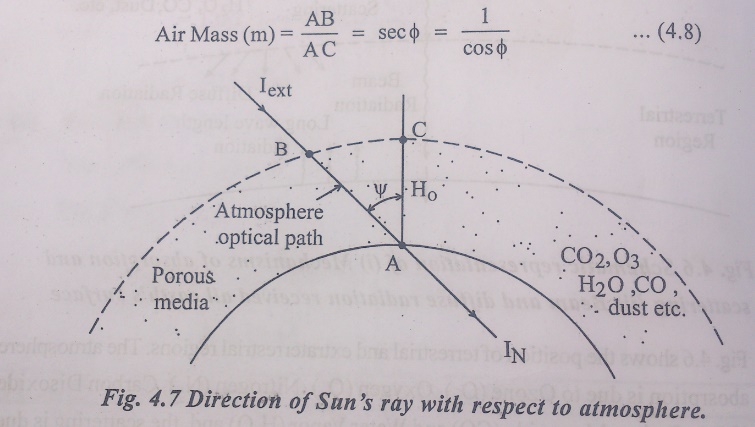Chapter: Electric Energy Generation and Utilisation and Conservation : Solar Radiation and Solar Energy Collectors
Solar Radiation at the EarthŌĆÖs Surface
Solar Radiation
at the EarthŌĆÖs Surface
Solar
radiations while passing through the earthŌĆÖs atmosphere are subjected to the
mechanism of atmospheric absorption and scattering. A fraction of the radiation
reaching the earthŌĆÖs surface is reflected back into the atmosphere and is
subjected to these atmospheric phenomenon again, the remainder is absorbed by
the earthŌĆÖs surface. Absorption occurs due to the presence of water vapour and
ozone in the atmosphere and other particulate matter. The sattered radiation
redistributed in all directions, some going back into space and some reaching
the earth surface.

Fig.
4.6 shows the position of terrestrial and extraterrestrial regions. The
atmosphere absorption is due to Ozone (O3), Oxygen (O2),
Nitrogen (N2), Carbon Disoxide (CO2), Carbon Monoxide(CO)
and Water Vapor(H2O) and, scattering is due to Air molecules, Dust
and Water Droplets. The X-rays and extreme Ultra-Violet radiations of the Sun
are absorbed highly in the ionosphere by nitrogen, Oxygen and other atmospheric
gases: ozone and water vapours largely absorb ultraviolet (l<0.4╬╝m)
and infrared radiations (l>2.3╬╝m) respectively. There is almost
complete absorption of short wave radiations (l<0.29╬╝m) in
the atmosphere. Hence, the energy in wavelength radiation below 0.29 ╬╝m and
above 2.3 ╬╝m of the spectra of the solar radiation, incident on the earthŌĆÖs
surface is negligible.
Scattering
by air molecule water vapour and dust particles in the attenuation of
radiation. The range of wavelength radiation emitted from the sun, attenuation
of its amplitude during propagation from the sun to atmosphere and further
attenuation of radiation in the atmosphere and also the long wavelength
radiation emitted from the earth as shown in ig.4.6.
The
atmosphere attenuation is characterized by the term called Air Mass (AM or m).
It is defined as the ratio of the optical thickness of the atmosphere through
which beam radiation passes to the optical thickness if the Sun were at zenith.
Large value of air mass indicates that solar radiation travel greater distance in
atmosphere. Hence is prone to attenuation. An expression for air mass
(Referring to Fig.4.7) is given by,

At
Noon, ŽĢ=0, m=1, for ŽĢ=60o, m=2 and m=0 for outside earth atmosphere.
Thus,
from the view of terrestrial applications of solar energy , only radiation of
wavelength between 0.29 and 2.3 ╬╝m is significant.
The
solar radiation, through atmosphere reaching the earthŌĆÖs surface can be
classified into two components, they are beam and diffuse radiation.
1.
Beam Radiation (Ib) : It is solar radiation propagating along the
line joining the receiving surface and Sun. It is also referred to as direct
radiation.
2.
Diffuse Radiation (Id): It is the solar radiation scattered by
aerosols, dust and molecules. It does not have unique direction.
Related Topics